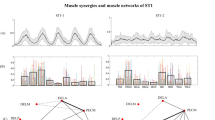Abstract
It has long been assumed that the human central nervous system uses flexible combinations of several muscle synergies to effortlessly and efficiently control redundant movements. However, whether muscle synergies exist in the neural circuit remains controversial, and it is critical to examine the association between the recruitment pattern of synergies and motor output. In this study, we examined the relationship between the activation of muscle synergies and endpoint force fluctuations in the presence of signal-dependent noise. Subjects performed multi-directional isometric force generations around the right ankle on the sagittal plane. We then extracted muscle synergies from measured electromyogram (EMG) data using nonnegative matrix factorization. As a result, the sum of the activation of muscle synergies was correlated with the endpoint force variability from the desired directions. Furthermore, we determined that the activation trace of each synergy reflected the endpoint force fluctuations using cross-correlation analysis. Therefore, these results suggest that muscle synergies statistically calculated from EMG data should be related to the motor output.









Similar content being viewed by others
References
Berger DJ, d’Avella A (2014) Effective force control by muscle synergies. Front Comput Neurosci 8(46):1–13
Bernstein N (1967) The coordination and regulation of movements. Pergamon Press, New York
Bizzi E, Cheung VCK (2013) The neural origin of muscle synergies. Front Comput Neurosci 7(51):1–6
Chvatal SA, Torres-Oviedo G, Safavynia SA, Ting LH (2011) Common muscle synergies for control of center of mass and force in nonstepping and stepping postural behaviors. J Neurophysiol 106:999–1015
d’Avella A, Saltiel P, Bizzi E (2003) Combinations of muscle synergies in the construction of natural motor behavior. Nat Neurosci 6(3):300–308
d’Avella A, Portone A, Fernandez L, Lacquaniti F (2006) Control of fast-reaching movements by muscle synergy combinations. J. Nerosci 26(30):7791–7810
d’Avella A, Fernandez L, Portone A, Lacquaniti F (2008) Modulation of phasic and tonic muscle synergies with reaching direction and speed. J Neurophysiol 100:1433–1454
Hagio S, Kouzaki M (2014) The flexible recruitment of muscle synergies depends on the required force-generating capability. J Neurophysiol 112(2):316–327
Hagio S, Nagata K, Kouzaki M (2012) Region specificity of rectus femoris muscle for force vectors in vivo. J Biomech 45:179–182
Harris CM, Wolpert DM (1998) Signal-dependent noise determines motor planning. Nature 394:780–784
Hart CB, Giszter SF (2004) Modular premotor drives and unit bursts as primitives for frog motor behaviors. J Neurosci 24(22):5269–5282
Hart CB, Giszter SF (2010) A neural basis for motor primitives in the spinal cord. J Neurosci 30:1322–1336
Haruno M, Wolpert DM (2005) Optimal control of redundant muscles in step-tracking wrist movements. J Neurophysiol 94:4244–4255
Imagawa H, Hagio S, Kouzaki M (2013) Synergistic co-activation in multi-directional postural control in humans. J Electromyogr Kinesiol 23(2):430–437
Jacobs R, van Ingen Schenau GJ (1992) Control of an external force in leg extensions in humans. J Physiol 457:611–626
Jones KE, Hamilton AFC, Wolpert DM (2002) Sources of signal-dependent noise during isometric force production. J Neurophysiol 88:1533–1544
Kouzaki M, Shinohara M, Masani K, Kanehisa H, Fukunaga T (2002) Alternate muscle activity observed between knee extensor synergists during low-level sustained contractions. J Appl Physiol 93:675–684
Kurtzer I, Pruszynski JA, Herter TM, Scott SH (2006) Primate upper limb muscles exhibit activity patterns that differ from their anatomical action during a postural task. J Neurophysiol 95:493–504
Kutch JJ, Valero-Cuevas FJ (2012) Challenges and new approaches to proving the existence of muscle synergies of neural origin. PLoS Comput Biol 8(5):e1002434
Kutch JJ, Kuo AD, Bloch AM, Rymer WZ (2008) Endpoint force fluctuations reveal flexible rather than synergistic patterns of muscle cooperation. J Neurophysiol 100:2455–2471
Lee DD, Seung HS (1999) Learning the parts of objects by non-negative matrix factorization. Nature 401:788–791
Masani K, Popovic MR, Nakazawa K, Kouzaki M, Nozaki D (2003) Importance of body sway velocity information in controlling ankle extensor activities during quiet stance. J Neurophysiol 90:3774–3782
Roh J, Rymer WZ, Beer RF (2012) Robustness of muscle synergies underlying three-dimensional force generation at the hand in healthy humans. J Neurophysiol 107:2123–2142
Roh J, Rymer WZ, Perreault EJ, Yoo SB, Beer RF (2013) Alterations in upper limb muscle synergy structure in chronic stroke survivors. J Neurophysiol 109(3):768–781
Takei T, Seki K (2010) Spinal interneurons facilitate coactivation of hand muscles during a precision grip task in monkeys. J Neurosci 30:17041–17050
Ting LH, Macpherson JM (2005) A limited set of muscle synergies for force control during a postural task. J Neurophysiol 93:609–613
Todorov E, Jordan M (2002) Optimal feedback control as a theory of motor coordination. Nat Neurosci 5:1226–1235
Torres-Oviedo G, Ting LH (2007) Muscle synergies characterizing human postural responses. J Neurophysiol 98:2144–2156
Torres-Oviedo G, Ting LH (2010) Subject-specific muscle synergies in human balance control are consistent across different biomechanical contexts. J Neurophysiol 103:3084–3098
Torres-Oviedo G, Macpherson JM, Ting LH (2006) Muscle synergy organization is robust across a variety of postural perturbations. J Neurophysiol 96:1530–1546
Tresch MC, Jarc A (2009) The case for and against muscle synergies. Curr Opin Neurobiol 19(6):601–607
Tresch MC, Saltiel P, Bizzi E (1999) The construction of movement by the spinal cord. Nat Neurosci 2(2):162–167
Vos EJ, Mullender MG, van Ingen Schenau GJ (1990) Electromechanical delay in the vastus lateralis muscle during dynamic isometric contractions. Eur J Appl Physiol 60:467–471
Zar JH (1999) Biostatistical analysis. Prentice-Hall, Upper Saddle River
Acknowledgments
This work was supported, in part, by a grant from the Descente and Ishimoto Memorial Foundation for the Promotion of Sports Science (M. Kouzaki).
Conflict of interest
The authors declare there are no competing financial interests.
Author information
Authors and Affiliations
Corresponding author
Rights and permissions
About this article
Cite this article
Hagio, S., Kouzaki, M. Recruitment of muscle synergies is associated with endpoint force fluctuations during multi-directional isometric contractions. Exp Brain Res 233, 1811–1823 (2015). https://doi.org/10.1007/s00221-015-4253-5
Received:
Accepted:
Published:
Issue Date:
DOI: https://doi.org/10.1007/s00221-015-4253-5




